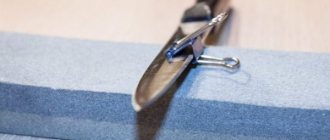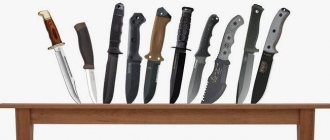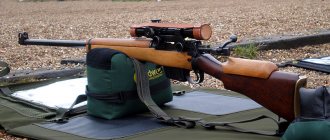Throwing knife cobra Throwing knife scorpion Throwing knives characteristics DIY throwing knives Throwing kunai knives How to throw knives
Surely everyone knows the sport of knife throwing. Due to the fact that throwing knives are more perceived as combat knives, purchasing them requires special permission. There are certain legislative norms by which the possibility of carrying a throwing weapon is determined; it depends on the characteristics of its use and specific circumstances.
Manufacturing technology
photo throwing knives now ; they are presented in huge quantities on the Internet. Despite the fact that in principle any knife can be thrown, there are still special designs designed for this. For example, to improve the movement of a body thrown in space (ballistics), the blade itself is made heavier compared to the handle. The throwing knife is often spear-shaped and may have no blade at all.
The process of making a really good throwing knife takes a long time and requires a lot of patience. Steel for throwing knives should be hard, but not very brittle. In some cases, a spring type of steel is used, which is found in cars and trucks. In cases where it is too thick or crooked, it is necessary to forge it in a forge, and the forging must be hot. As a result, the steel plate must be at least 4 mm thick.
At the next stage of production, it is necessary to decide on the shape. Ideally, it will be without recesses, protrusions and holes, in a word, as simple as possible. It is important that the knife fits well in your hand and is not too small. The most difficult step is grinding the thickness of the plate to the desired size. If you do this yourself, you need to be prepared for the fact that it will take a lot of time.
Next comes the sharpening procedure. Sharpening of throwing knives is carried out using whetstones and whetstones. To begin with, take a rough block and sharpen it so that a burr (a thin strip of metal) appears along its entire length. From this you can understand whether you will be able to sharpen the blade in the future. When sharpening, it is important to ensure that the resulting blade is even. Sometimes, in the area of the nose, the knife is sharpened from the top and bottom sides.
What steel are throwing knives made of? How to choose your first throwing knife?
If you want to learn how to throw knives or if you are already into the art, you will definitely want the best throwing knives on the market today. Quality throwing knives are made from selected materials, all of which ensure the durability of the product. The knives have a unique design and are intentionally heavy. The design of the knife makes it easy to use.
Throwing knives come in a variety of sizes, shapes and designs, so for the neophyte or adept, there are many exceptional models to buy. Investing in knife throwing is a serious undertaking that requires careful planning and consideration.
Types of throwing knives
The best throwing knives come in a wide variety of models; they can be divided by weight, blade shape, and balancing. Combat throwing knives , differing in weight, vary in length, width and thickness of the blade. So, ultra-light knives are also called dart knives or arrowhead knives. At their core, they are lightweight, unable to fly long distances, and can change their trajectory depending on the direction of the wind. For these reasons, small throwing knives are more used for home training purposes. Often sold in sets of 3-6 pieces.
But for the first training, light knives are ideal; with their help it is much easier to master the throwing technique. The fact is that when using a heavy knife, at the moment you swing your hand, the entire load goes on the wrist and hand, which have not yet been trained. From the photo of throwing knives in the light weight category, you can see that their approximate length is about 16-22 cm, and the length of the blade itself is about 11 cm. There are also knives of medium weight and heavy ones. The latter type is used for long-distance throwing. They are well suited for people with the appropriate build and palm size.
Selecting the type of throwing knives
Previously, throwing blades were not as common as they are now. They were forged and sawed by artisans. Nowadays there are all kinds of kits on sale, but in sports throwing there are several varieties. Depending on the purpose of each of them, the specific choice is determined.
1. Ultralight. They are distinguished by their smallest size, which makes them look like arrowheads or darts. It will not be possible to launch such a knife at a far away target - even a small gust of wind will knock it off the correct trajectory. Start with the simplest thing: a standard set of 3-6 pieces and a dart board as a target.
2. Lungs. The best option for those who are just looking at this sport. Light weight will help beginners train their hands and avoid injuries when the wrong load is placed on the wrist when swinging the arm. The weight of such a blade ranges from 50-80 grams.
3. Average weight. These are already professional tools with a sufficient reserve of destructive power. Their length varies from 20 to 25 centimeters, and their approximate weight is 120-200 grams.
4. Heavy. People of impressive size simply find it inconvenient to use lighter options, so they prefer knives weighing 200 grams or more. Such blades can be thrown over long distances.
Sports throwing knives of various shapes
Basically, they all have a skeletal type and are presented in a single design. Some are more convenient to throw by the handle, others by the blade, and some by both methods. There are sport throwing knives with a curved blade shape and one-sided sharpening. Some people like dagger-type knives that have the appearance of an elongated bullet. In order to better enter the target, the tip of the false blade is sharpened. Experts say that this type is best suited for beginner throwers.
There are people for whom the best throwing knife is one with a wide leaf-shaped blade. This type is best thrown by the handle. In addition, there are different blade widths and handle shapes. The Storm throwing knife is a representative of an unusual design that does not belong to a specific form. It is easy to control for all types of throws, making it very practical. Some use Japanese throwing knives for collection. Often there are weapons that resemble a miniature spear, scalpel or pike.
Distinctive balancing characteristics
Experts distinguish professional throwing knives by their balancing features. It happens:
- neutral:
- in the area of the blade;
- in the area of the handle.
The combat throwing knife of the first group can be sent to the target in two ways, holding it by the handle or blade. This item is effective regardless of the distance to the target. Used for non-revolving throw, to the floor and full rotation.
The balance of a throwing knife can be centered on the handle. This option is best used in close combat; maximum accuracy can be achieved by throwing it by the blade. As for knives with blade balance, they are grabbed by the handle before throwing. This way you will ensure the highest accuracy of throwing over a long distance.
We must not forget that the way a throwing knife looks depends on how accurately the area will be hit in certain situations. All this must be taken into account when selecting this item.
Cases for throwing knives
In order to avoid the unwanted effect of a sharp object, which can injure a person or damage surrounding objects during storage and transportation, sheaths for throwing knives . In addition, the sheath protects the weapon from the negative effects of the environment, such as rusting. They are often part of clothing, sometimes even decorated with inserts of valuable metals or stones. Beautiful throwing knives require adequate storage space.
All types of throwing knives require special cases, in the manufacturing process of which a variety of materials with a high level of strength are used. Their role can be wood, various types of fabrics, leather and metals. The design includes special loops, ties or rings that are used to secure the sheath to a belt or clothing. Previously, in order to protect a professional throwing knife from damage and protect yourself, you had to sew a cover yourself. Now sheaths are presented in a large assortment in specialized stores.
It is difficult to say what the best throwing knives are , but as for the sheath for them, they must meet certain requirements. Key points to consider during the selection process:
- the need for a fastening strap;
- Is a flexible fastening system needed?
- the main part must be sewn from a single piece;
- the cover must completely and tightly cover the blade;
- the size should be as small as possible;
- The manufacturability of the sheath is also important.
Mercury throwing knife, myth or reality?
There are many legends and rumors surrounding knives for various purposes. I would like to especially highlight mercury throwing knives , what are they and do they really exist? The legend about this type of throwing knife is passed down from generation to generation. According to her, this knife is extremely secret; it was in service with Soviet saboteurs among elite units. Despite the level of secrecy, there are people who claim to know about it and have even held it in their hands.
If you find a photo of mercury throwing knives, you can see that it contains combat metal – mercury. It is believed that this is what allows the saboteur to achieve several goals at the same time. First of all, due to the balancing of mercury in the blade, the knife confidently hits the target, regardless of distance. If you use a weapon for the purpose of attack, then when the enemy is defeated, the mercury that penetrates into the body poisons the organs. According to legend, in a moment of hopelessness, a fighter can take mercury and end his life; a mercury knife is also indispensable when, for obvious reasons, it is not possible to provide medical assistance.
Of course, theoretically the idea with an inertial body in a knife can be implemented. This may have a slightly different appearance, namely with a cavity in the handle. Perhaps, in words, such a knife will have a high level of piercing energy, but how effective this will be in practice is a question. Therefore, it should be concluded that the mercury throwing knife is still a myth. A folding throwing knife is also not practical.
Rating of throwing knives
There are many knives that are used in sports. However, it is worth noting that real throwing knives have a simple design and a high degree of metal viscosity. The most important characteristics are the weight and length of the throwing knife . Its damaging ability and the necessary effort to throw it depend on this.
As already mentioned, knives come in different designs, among them there are the most common ones, of which a specific list can be compiled. Names of throwing knives :
- "Druzhban";
- "Leader";
- "Sturgeon;
- "Hit";
- "Krom";
- "Stork";
- "Vyatich".
All throwing knives do not have a clearly defined handle, much less a stop-limiter. This makes it impossible to use it in hand-to-hand combat. Standard knives are made of steel grade 30ХГСМ.
The selection of throwing weapons is an individual matter for everyone. It depends on the degree of skill, financial resources and many other factors. But we must not forget about safety rules during its operation.
" Throwing Knives" read 2752 times
Throwing knives
A throwing knife is a type of knife and is used as a throwing weapon. At the everyday level, you can throw a knife of any design and configuration, but for throwing knives as a sport, special throwing knives are used, the characteristics of which meet certain standards.
They have their own characteristics: 1. They have a more simplified handle. There is no guard or stops on the handle. Due to this, the weight of the knife is reduced and ballistics are improved;
2. The handle has no pads. Typically, for knives, the handle is made of wood or special polymers that cannot withstand the force of impact on the target, so they easily break and render the knife unusable for throwing;
3. There is often a hole on the handle of a throwing knife that allows you to thread a rope through it. It can be used to attach it to a belt or when using a knife as a harpoon, a “cat”, and then returning it to the hands of the thrower.
At knife throwing competitions, which have official status as sports, knives of a single type are used, which is approved by Unifight. The length of such a knife corresponds to 260mm, while the length of the blade is 150mm, the thickness of the butt of this sports equipment is 6 mm, and the weight is 285 grams. The tip of the knife should be sharp, but no special sharpening is required. The blade must be marked with the sign of the Unifight federation and the manufacturer's mark. It must have a certificate and is classified as a household item, not being a bladed weapon.
At official competitions, three types of knives are usually used:
Throwing knife "Sturgeon". It was invented by Vladimir Kovrov. It is made of steel grade 30ХГСМ. It is one of the favorite and sought-after types of throwing knives. Until 2012 it was used at official sports competitions. It is preferred to be used by more experienced athletes who have already developed their own technique. However, some trainers begin classes with beginners with these throwing knives.
Throwing knife "Leader". Its designer is also Vladimir Kovrov. In this knife model, the center of gravity is shifted towards the blade. The knife is thrown holding the handle. Its narrow blade and light weight perfectly compensate for the “shortcomings” of throwing skills. The characteristics of the Leader throwing knife allow it to be used by everyone.
The Unifight PRO throwing weapon was developed by Vitaly Kim and has wider parameters of the butt and weight. Available in two modifications: “Unifight PRO” and “Unifight PRO-L”. The latest model is specifically designed for women's and junior competitions. Today, these two models are the official sports equipment at competitions held by the Unifight federation.
How to choose a throwing knife
Knife throwing is becoming more and more popular every year. Therefore, if you are going to start doing this interesting business, you need to know how to choose the right throwing knife. A beginner should not buy an expensive throwing knife. Externally, a suitable knife may look very simple - an ordinary steel blade, often without a wrap for the handle. The same applies to sheaths; they can be made of inexpensive synthetics. If you have no experience in such matters, and you don’t know how to choose a throwing knife, then it is better to trust the advice of experienced knife throwers who have tried various models in practice. This will ensure that your knife does not fall into pieces the first time you throw it at the target.
What should those who don’t know which throwing knives to choose pay attention to? First of all, on the size of the knife and balance. The shape of the blade and the weight of the knife are also important. If the knife is not well balanced, then you can forget about throwing accuracy. It is especially important for a beginner to purchase a knife with good balancing, so that later he does not have to relearn. Separately, you should pay attention to the steel from which the knife is made. The blade should not be too fragile to be reused.
A beginner who is just taking his first steps in this fascinating art can be advised to purchase a TK080 knife, manufactured by. This is a fairly simple knife, it has a low price, so it is available to a wide range of buyers. However, its simplicity did not affect the quality. TK080 is made of wear-resistant 420 steel, hardness 54-56 HRC. The edge of the blade is not sharpened too much, so you can pick it up without fear of cutting yourself. At the same time, the shape of the blade and balance allow it to fly extremely accurately to the target - an important condition for those who do not know which throwing knives to choose. The total length of the TK080 is two hundred and five millimeters, with a blade length of one hundred millimeters. The all-metal handle, twenty-one millimeters wide, allows the use of various knife throwing techniques. The width of the blade is as much as five millimeters - a guarantee that even at first, if the knife is handled ineptly, it will not break. This knife is equipped with a separate fabric sheath, so it can be carried in a pocket or on a belt. This inexpensive knife can be recommended to all throwing enthusiasts.
DIY throwing knives
There are now a lot of varieties of knives and they are all designed to solve specific problems. Most knives in existence today are multifunctional devices because they can be used to perform various purposes. But there is a category of knives, so-called, narrowly focused, which are created for specific tasks and have a specific purpose. Throwing knives can be classified as devices with a narrow focus.
So, in order to make throwing knives with your own hands, you first need to prepare the material for their manufacture. First you need to trim the steel if the selected piece is crooked or very thick, but you must first forge this metal. To make a blowing knife, a flat piece of metal of the required thickness must be used. It is also worth noting that the metal for making a knife must be solid and smooth, since it is believed that a throwing knife with decorative holes, notches or protrusions on the blade is less effective than a throwing knife with a straight blade.
Once a suitable piece of steel has been selected, you can proceed to the next stage of making a throwing knife, namely creating a drawing.
It is worth noting that a homemade throwing knife must meet certain parameters:
the thickness of the knife should be within 2.5-3 millimeters; the length of the knife blade should not exceed 15 centimeters; the width of the throwing knife should be 25 centimeters; the handle of the throwing knife should be 10 centimeters long.
These are the main parameters of a throwing knife, which are considered optimal for the knife to perform its functions efficiently. The planned shape of the knife, taking into account the above dimensions, must be transferred to the drawing. The scale of the drawing should be 1:1, this will help ensure the correctness of the design. After completing the drawing, the design of the device must be cut out and transferred to a steel blank. When applying a knife design to steel, you must ensure that there are no “shells” in the blade area.










